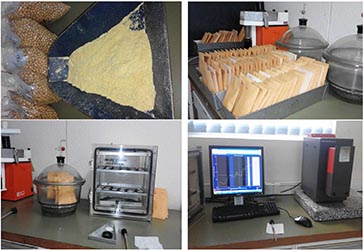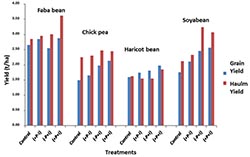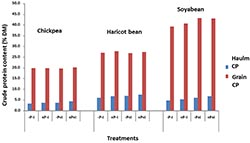Grain legumes are the second largest cultivated crops in Ethiopia next to cereals in terms of total production volume yield and area coverage. A similar scenario is reported for annual crop residue production from grain legumes. But both grain and haulm production from grain legumes are below their potential and need to be improved through different approach like developing new varieties and adhering to better agronomic practices to exploit the genetic potential of the plants. Enhancing nitrogen fixation efficiency of grain legumes by inoculation of seeds with effective rhizobium strains and application of phosphorus fertilizers is a possible, thus increasing plant available nutrient (nitrogen and phosphorus) improving yield and quality of the crops.
|
To this end, a study was conducted to evaluate effects of rhizobium inoculation and P fertilizer on yield and quality of grain and haulms of N2Africa-Ethiopia target legume crops (Faba bean, chickpea, haricot bean and soyabean) in the mixed farming system of Ethiopia during the main cropping season of 2015. To attain the proposed objectives of the study, yield data and, grain and haulm samples were collected from demonstration plots established on-farm using these four grain legumes. The crops were subjected to four soil fertility treatments (inoculation + P fertilizer (+P+I), inoculation alone (-P+I), P fertilization alone (+P-I) and control i.e. no inoculation and no fertilizer (-P-I)). Then samples were analyzed for nutritional value parameters at Animal Nutrition Laboratory of ILRI, Addis Abeba campus, Ethiopia. NIRS predication was employed for analysis of the intended nutritional value variables. On the right: Figure 1. Sample processing and analysis for quality parameters at Animal Nutrition Laboratory of ILRI, Addis Abeba, Ethiopia |
 |
The study showed that both grain and haulm DM yield of all studied crops, except chickpea haulm yield were improved due to the application of the soil fertility treatments (Figure 2). Improvement achieved with combined application of the two inputs (rhizobium inoculants and P fertilizer) was more prominent than that obtained for separate applications of the inputs in most cases. Similarly, the soil fertility treatments have resulted in significant improvement of nutritional values of both grain and haulm of the grain legumes. Increased grain and haulm crude protein contents of all the crops were evident with the applications of the soil fertility treatments except chickpea grain (Figure 3). The current findings show the possibility of simultaneous improvement of both grain and haulm yields of the legumes in the mixed farming system where both products are important for the smallholder farmers. However, variability was observed among crop types in their responses to separate and combined application of the two inputs and also across locations.
 |
Left: Figure 2. Grain and haulm dry matter yield (t/ha) responses of grain legumes to rhizobium inoculation and/or P fertilizer during main cropping season of 2015 Right: Figure 3. Effects of rhizobium inoculation and phosphorus fertilizer on grain and haulm crude protein contents of grain legumes during main cropping season of 2015 |
 |
For more information see the MSc thesis “Effects of phosphorus fertilizer and inoculation on yield and nutritive values of grain and haulm of selected grain legumes in mixed crop-livestock production system of Ethiopia”
Sisay Belete, Adugna Tolera, Melkamu Bezabih, Birhan Abdulkadir and Endalkachew Wolde-meskel
